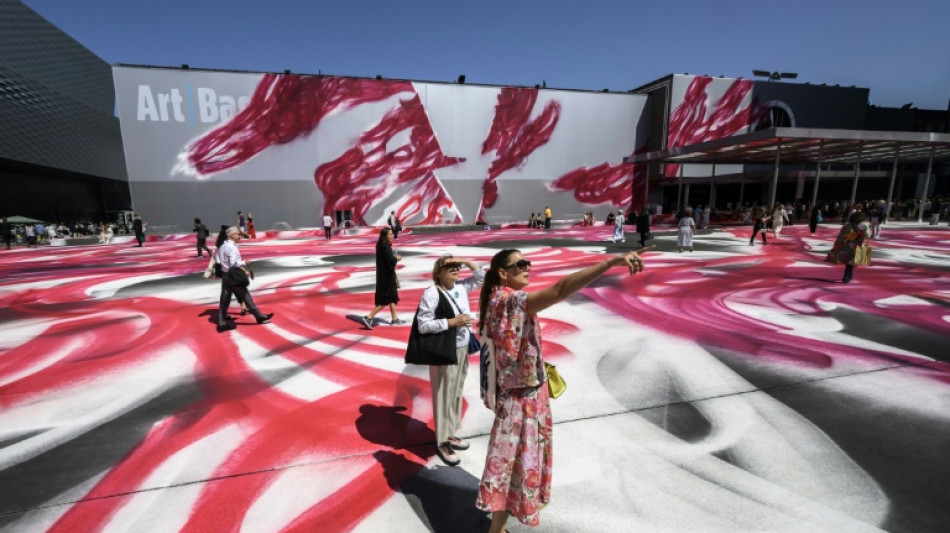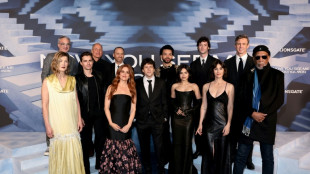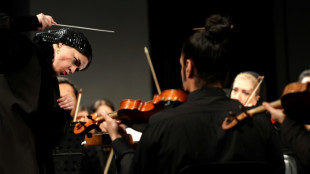

Utopia and fragile democracy at Art Basel fair
This year's Art Basel, the world's top contemporary art fair, paints a portrait of a troubled planet, with works embodying the relentless pursuit of happiness and the fragility of democracies.
The four-day event in the northern Swiss border city of Basel, which closes on Sunday, features more than 280 galleries presenting works by around 4,000 artists.
The monumental works section features an 85-metre-long installation entitled "The Voyage -- A March To Utopia".
Created by the studio of Dutch artist Joep van Lieshout, it features 80 large sculptures forming a procession of absurd objects, where "everybody walks in the same direction... on their way to a happy place", the artist told AFP.
The journey begins with a team of oxen, followed by all means of getting to that better world, including a walking stick, a cart, a toilet on wheels, a wheelchair and a mobile surgical theatre for those struggling to keep up.
Next come objects representing everything the convoy is carrying, followed by sculptures of ghosts symbolising those who didn't make it to the end.
It ends with machines set to destroy the road behind them, so that "there's no going back", the artist explained.
- Flag of logs -
A stone's throw away, Spanish artist Jaume Plensa presents a work composed of 21 aluminium doors engraved with the articles of the Universal Declaration of Human Rights adopted by the United Nations General Assembly in 1948.
Entitled "Forgotten Dreams", it invites viewers to contemplate collective aspirations and not forget the horrors of the past.
Vietnam-born Danish artist Danh Vo has installed a huge US flag made from hundreds of logs and 13 steel stars, referencing the first version of the flag from 1777.
Reconstructed at Art Basel, "In God We Trust" was first created in 2020, during the presidential election campaign between Donald Trump and Joe Biden.
The logs were removed one by one and burned in fireplaces, gradually causing the flag to disappear.
The work serves as an allegory of the fragility of US democracy.
- Go-go dancers -
Art Basel is above all a commercial event, where artists and galleries come to meet wealthy collectors.
But the fair is also very popular with art lovers who come for the simple pleasure of browsing the works on show.
Its "Unlimited" section brings together monumental pieces intended for museums and major collections.
It includes recent as well as older works, including a performance created in 1991 by Felix Gonzalez-Torres, a US artist from Cuba who died of AIDS in 1996.
Called "'Untitled' (Go-Go Dancing Platform)", it features a man dressed in silver shorts dancing on a podium for a few minutes, twice a day.
"It's an interesting moment to revisit it," said the "Unlimited" section's curator, Giovanni Carmine, recalling that the artist created the performance shortly after the death of his partner from AIDS, "in a context that was also very reactionary".
Gonzalez-Torres responded with "a very political gesture" with a performance that is "a celebration of life".
- Angels and light -
The "Unlimited" hall features 67 works, including three angels by German sculptor Thomas Schutte, which foster "a certain ambivalence", said Carmine.
With "their wings resembling razors", are they "protective angels or angels of the apocalypse?", he asked.
Japanese artist Izumi Kato brings a touch of poetry with his stone structures, painted with enigmatic faces, drawing on the Japanese tradition that each stone contains a spirit.
US artist Arlene Shechet plays on contrasts, with a heavy orange abstract sculpture designed to give an impression of lightness despite its weight.
"The current political situation is dark and so bringing light and colour and joy and spirit and art is very meaningful," she told AFP.
G.Galli--GdR



